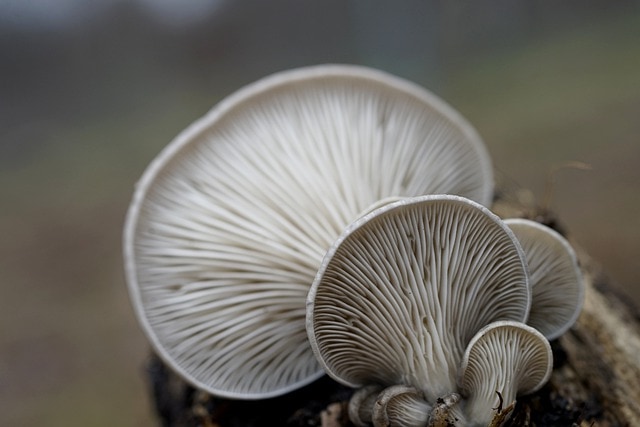Oyster mushrooms are a popular ingredient in many dishes and are known for their delicate taste and texture. However, it can be frustrating when you notice your Oyster mushroom turning yellow.
Yellowing can indicate a problem with the mushrooms and can make them less appealing to eat. In this article, we will explore the causes of yellowing in oyster mushrooms and what can be done to prevent it.
Understanding oyster mushrooms is key to preventing yellowing. These mushrooms grow best in high humidity with 80-95% moisture in the air. If they grow with insufficient humidity, the edges of their caps can turn a pale yellow color.
Additionally, yellowing can be a sign of fungal diseases that can arise from poor sanitation, contamination from other mushrooms, or environmental stressors. It is important to identify the cause of yellowing to prevent it from happening in the future.
Key Takeaways on Oyster Mushroom Turning Yellow
- Oyster mushrooms can turn yellow due to insufficient humidity or fungal diseases.
- Proper cultivation and storage can help prevent yellowing in oyster mushrooms.
- Identifying the cause of yellowing is important to prevent it from happening again.
Also see:
- Orange Star Plant Leaves Turning Yellow
- Orange Star Plant Leaves Turning Yellow
- Oak Tree Leaves Turning Yellow in Summer
Understanding Oyster Mushrooms
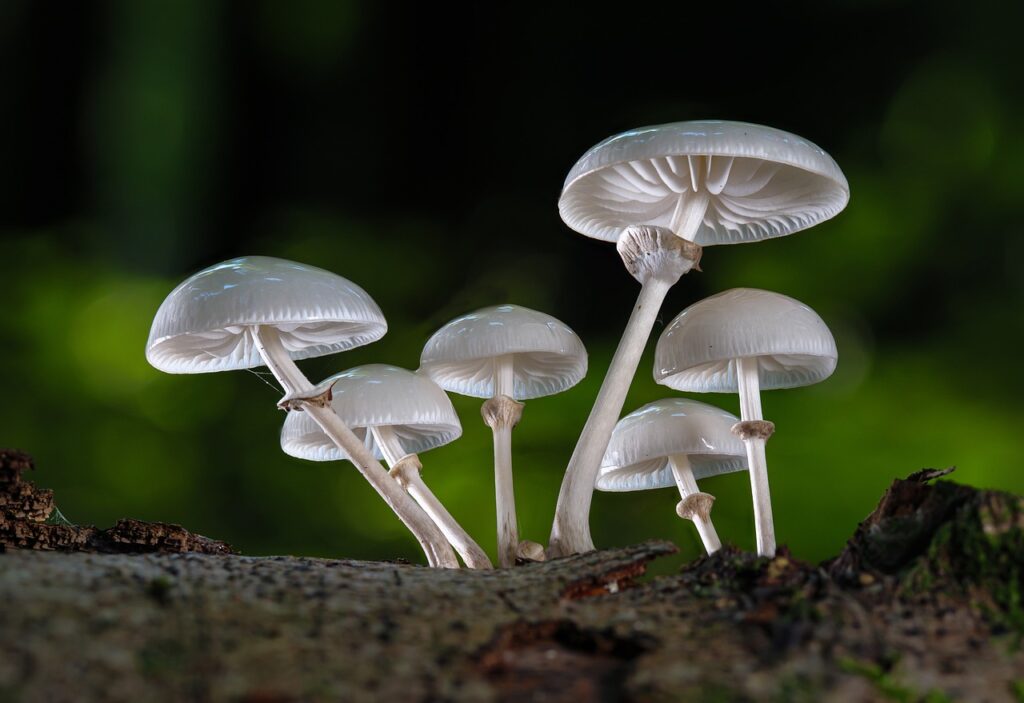
Oyster mushrooms, scientifically known as Pleurotus citrinopileatus, are a popular edible mushroom variety that is widely cultivated and consumed across the world. These mushrooms have a delicate texture and a mild, nutty flavor, making them a versatile ingredient in various dishes.
Oyster mushrooms are typically found growing on the logs of deciduous trees, such as beech, maple, and oak, or on hardwood sawdust. They are known to grow in clusters, and their caps can range in color from white, gray, tan, to even yellow.
These mushrooms have a delicate texture that can easily be damaged, so it’s important to handle them with care. They are best cooked quickly over high heat, such as stir-frying, grilling, or sautéing. Oyster mushrooms can also be used in soups, stews, and sauces.
In terms of habitat, oyster mushrooms prefer a humid environment with moderate temperatures. They are typically grown indoors in a controlled environment, such as a mushroom farm, where the temperature, humidity, and lighting can be adjusted to optimize their growth.
Cultivation of Oyster Mushrooms
Oyster mushrooms are a popular choice for home cultivators due to their ease of cultivation and delicious taste. They are typically grown on a substrate made of straw, sawdust, or a combination of the two. The mycelium, or vegetative part of the fungus, is added to the substrate and allowed to colonize it before fruiting occurs.
Humidity and temperature are crucial factors in the cultivation of oyster mushrooms. High humidity levels of 80-95% are necessary for proper growth, and temperatures should be kept between 65-75°F. Grow bags are often used to maintain humidity levels and provide a controlled environment for the mushrooms to grow.
Grain spawn is commonly used to inoculate the substrate with mycelium. This is typically done in a sterile environment to prevent contamination. Once the mycelium has colonized the substrate, it is ready for fruiting.
Oyster mushrooms are known to grow well on hardwood trees, such as oak or beech. However, they can also be grown on other types of substrates, such as coffee grounds or agricultural waste.
Air circulation and ventilation are important for maintaining proper humidity levels and preventing the buildup of carbon dioxide. Home cultivators can use a humidifier or fan to regulate humidity levels and ensure proper air circulation.
Oyster mushrooms can be grown year-round, but they tend to fruit more prolifically in the spring and fall. It is important to monitor humidity levels and adjust ventilation accordingly to ensure optimal growing conditions.
Yellowing of Oyster Mushrooms
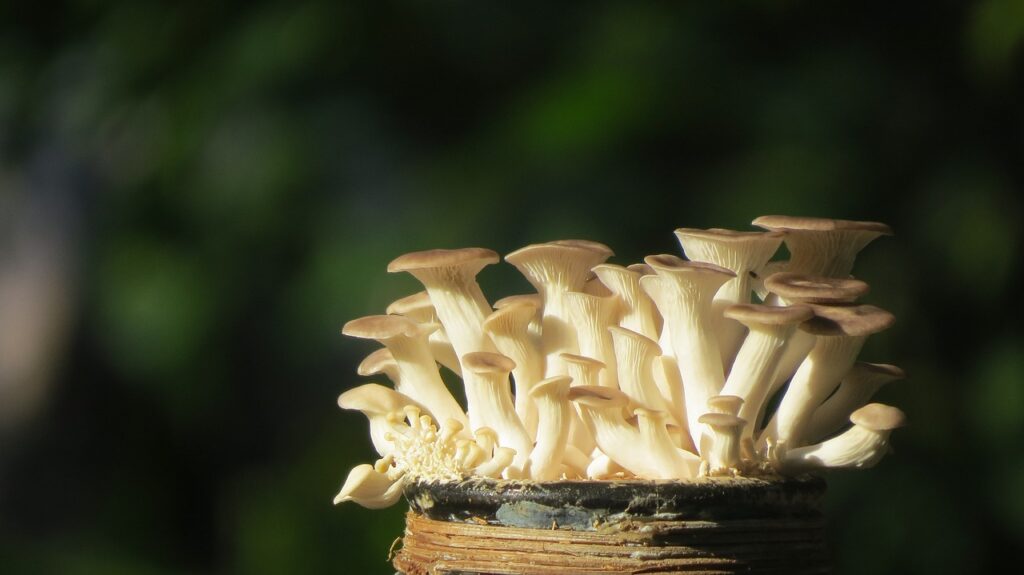
Oyster mushrooms are a popular choice for home growers due to their ease of cultivation and delicious taste. However, sometimes these mushrooms can turn yellow, which can be a cause for concern.
Yellowing of oyster mushrooms can occur due to a variety of reasons. One common cause is insufficient humidity, which causes the mushrooms to dry out. This can be fixed by applying a fine mist of water, even just on the substrate, to increase the humidity levels.
Another reason for yellowing of oyster mushrooms is exposure to too much light or heat. Mushrooms prefer cool, dark environments, so if they are exposed to too much light or heat, they might start to turn yellow. It is important to keep the mushrooms in a cool, dark place to prevent this from happening.
Sometimes, yellowing of oyster mushrooms can be due to a fungal or bacterial disease. This can be identified by the appearance of yellow spots on the caps. In such cases, it is important to remove the affected mushrooms immediately to prevent the spread of the disease to other mushrooms.
It is important to note that not all yellow oyster mushrooms are a cause for concern. Some oyster mushrooms are naturally yellow in color, like the golden oyster mushroom. These mushrooms are safe to eat and have a unique flavor profile.
Causes of Yellowing in Oyster Mushrooms
Yellowing in oyster mushrooms can be caused by a variety of factors. Environmental factors, poor substrate, pests, and diseases can all lead to yellowing.
Environmental factors such as inadequate ventilation, high humidity, and dry air can all cause yellowing in oyster mushrooms. Mushrooms thrive in cool, dark environments and exposure to too much light or heat can also cause yellowing.
Poor substrate can also cause yellowing in oyster mushrooms. If the substrate is not properly prepared, it can lead to a lack of nutrients which can cause yellowing. Additionally, fungal or bacterial disease can cause yellow spots to appear on the caps of the mushrooms.
Pests such as mites and flies can also cause yellowing in oyster mushrooms. These pests can carry bacteria and other contaminants that can infect the mushrooms.
One type of mold that can cause yellowing in oyster mushrooms is Trichoderma. This green mold can grow on the substrate or the mushrooms themselves and can cause yellowing and other discoloration.
Golden Oyster Mushrooms

Golden oyster mushrooms, also known as Pleurotus citrinopileatus, are a type of edible gourmet mushroom that belongs to the Pleurotaceae family. They are one of the smaller varieties of oyster mushrooms, and one of the most colorful. Their thin, delicate caps range in color from bright daffodil yellow to golden yellow.
Golden oyster mushrooms are naturally yellow, unlike other oyster mushrooms that turn yellow due to drying out, insufficient humidity, or damage. They have a rich, nutty flavor and a velvety texture, making them a popular ingredient in many dishes.
These mushrooms are relatively easy to cultivate, making them a favorite among mushroom growers. They grow best in warm, humid environments and are usually ready for harvest within 3 to 4 weeks. Golden oyster mushrooms are also known for their medicinal properties, which include anti-inflammatory and antioxidant properties.
When cooking with golden oyster mushrooms, it is important to avoid overcooking them as they can become tough and lose their delicate flavor. They are best cooked quickly over high heat, such as in stir-fries, soups, or sautés. Golden oyster mushrooms can also be used as a meat substitute in vegetarian or vegan dishes due to their meaty texture.
Identifying Bad Oyster Mushrooms
Oyster mushrooms are a popular ingredient in many dishes due to their nutty flavor and silky texture. However, they can turn yellow and spoil if not stored or handled properly. Here are some ways to identify bad oyster mushrooms:
1. Appearance
Oyster mushrooms that have gone bad will have a slimy texture and a foul smell. They may also turn yellow or brown in color. If the mushroom cap is wet with water droplets, it is a sign of excess moisture and may lead to spoilage.
2. Texture
Freshly harvested oyster mushrooms have dry skin and a firm texture. If the texture becomes slimy or mushy, it is a sign that the mushroom has gone bad and should not be consumed.
3. Smell
Oyster mushrooms that have gone bad will emit a strong, unpleasant odor. If the mushroom smells bad, it is a sign that it has spoiled and should be discarded.
Storage and Shelf Life of Oyster Mushrooms
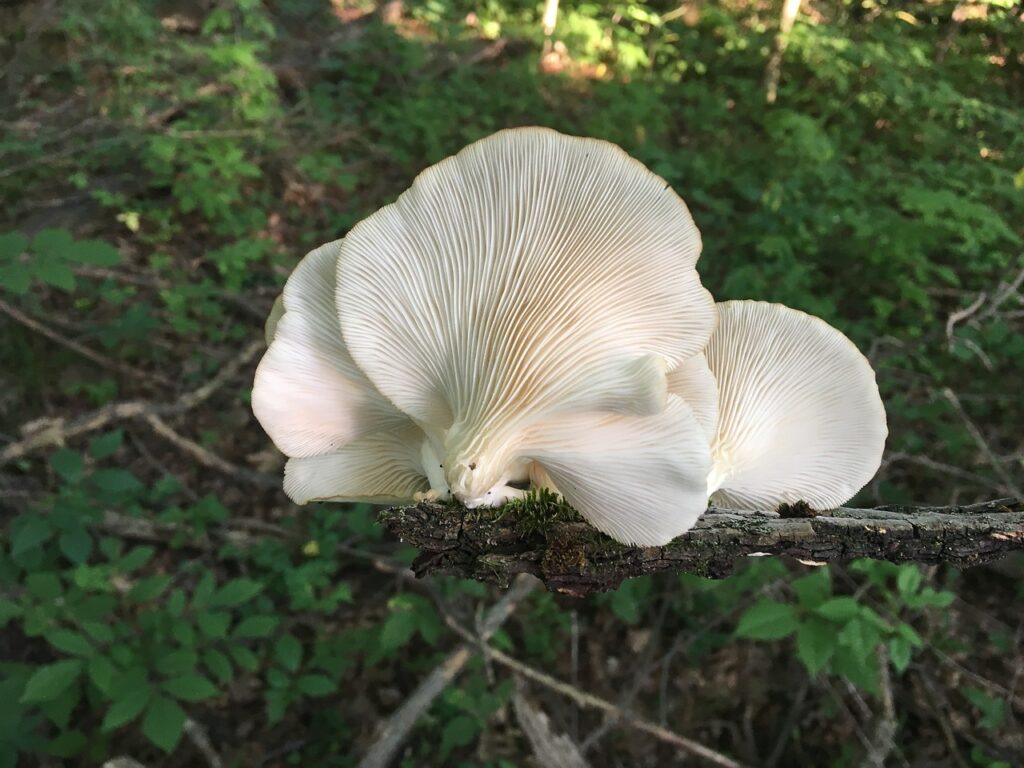
Oyster mushrooms have a relatively short shelf life when compared to other mushrooms. They can last up to a week in the fridge, but it is recommended to use them within 2-3 days for the best quality.
When storing fresh oyster mushrooms, it is essential to keep them dry and cool. Moisture can cause them to spoil quickly, so it is best to store them in a paper bag or a container with paper towels to absorb any excess moisture. Avoid storing them in plastic bags as they can trap moisture and cause the mushrooms to rot.
If you have a surplus of oyster mushrooms, you can consider freezing or dehydrating them. When freezing, it is best to blanch them first to preserve their texture. Dehydrated oyster mushrooms can last up to six months when stored in an airtight container in a cool, dry place.
Canning is another option for long-term storage of oyster mushrooms. Canned oyster mushrooms can last up to a year when stored properly. However, canning requires a bit of expertise, so it is recommended to follow a trusted recipe or consult a canning expert.
In summary, oyster mushrooms have a short shelf life and require proper storage to maintain their quality. Whether you choose to store them in the fridge, freezer, dehydrate, or can them, it is essential to keep them dry and cool to extend their shelf life.
Cooking with Oyster Mushrooms
Oyster mushrooms are a versatile ingredient that can be used in a variety of dishes. They have a mild, slightly nutty flavor and a tender texture that makes them a perfect addition to soups, stir-fries, and salads. They are also a great meat substitute for vegetarians and vegans.
To cook oyster mushrooms, it is important to clean them properly and remove any dirt or debris. Simply wipe them with a damp cloth or rinse them quickly under cold water. Avoid soaking them in water for too long, as they can become waterlogged and lose their flavor.
One popular way to prepare oyster mushrooms is to sauté them with garlic and butter. Heat a pan with some butter over medium heat, add minced garlic, and cook for a minute. Then add the mushrooms and cook until they are tender and lightly browned. Season with salt and pepper to taste.
Oyster mushrooms also pair well with bacon bits. Fry some bacon in a pan until crispy, remove it from the pan, and set it aside. Add sliced oyster mushrooms to the pan and cook until they are tender and lightly browned. Then crumble the bacon over the top and serve.
Oyster mushrooms have an earthy smell that can be enhanced by pairing them with other earthy ingredients such as potatoes, root vegetables, and herbs like thyme and rosemary. They also pair well with acidic ingredients like lemon juice and vinegar, which can help balance their flavor.
Prevention of Yellowing in Oyster Mushrooms

Yellowing in oyster mushrooms can be prevented by taking the right steps. Here are some tips for mushroom cultivators to prevent yellowing in oyster mushrooms:
1. Maintain Proper Humidity Levels:
Oyster mushrooms need a high level of humidity to grow. If the humidity is too low, the mushrooms can dry out and turn yellow. On the other hand, if the humidity is too high, the mushrooms can become waterlogged and turn yellow. Maintaining a humidity level between 80% to 90% is ideal for oyster mushrooms.
2. Provide Adequate Ventilation:
Proper ventilation is essential for oyster mushrooms. Poor ventilation can cause the growth of molds and bacteria, which can lead to yellowing of the mushrooms. Ensure that there is enough air circulation in the growing area to prevent the buildup of carbon dioxide and other harmful gases.
3. Use Quality Substrate:
The substrate used for growing oyster mushrooms should be of good quality. A substrate that is too wet or too dry can cause yellowing of the mushrooms. It is recommended to use straw as a substrate for oyster mushrooms as it retains moisture and provides the necessary nutrients for the mushrooms to grow.
4. Maintain Proper Nutrient Levels:
Oyster mushrooms require nutrients such as phosphorus and potassium to grow properly. A deficiency in these nutrients can cause yellowing of the mushrooms. Ensure that the substrate used for growing oyster mushrooms is rich in these nutrients.
5. Avoid Using Salt:
Salt is harmful to oyster mushrooms and can cause yellowing. Avoid using salt in the substrate or the growing area.
Yield and Production of Oyster Mushrooms
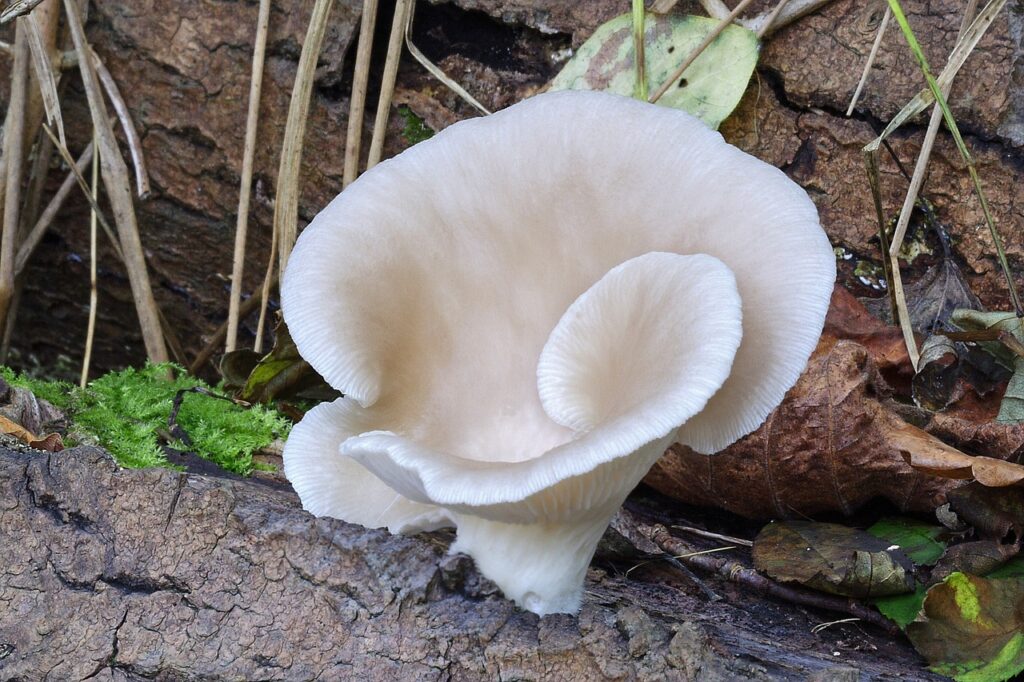
Oyster mushrooms are one of the most popular types of edible mushrooms due to their unique texture and flavor. They are also relatively easy to grow and harvest, making them a popular choice for home gardeners and commercial growers alike.
However, like any crop, oyster mushrooms have their own set of challenges when it comes to yield and production.
1. Yield
The yield of oyster mushrooms can vary depending on a variety of factors, including the strain of mushroom, the growing medium, and the temperature and humidity of the growing environment.
According to FreshCap Mushrooms, the expected yield of oyster mushrooms can range from 6-12 lbs from a 25 lb straw log, up to 3 lbs from a 5 lb supplemented sawdust fruiting block.
2. Fruiting Body
The fruiting body of the oyster mushroom is the part that is harvested and consumed. It is characterized by a delicate cap that can be easily damaged if not handled carefully.
To maximize yield, it is important to harvest the mushrooms at the right time, when the caps are fully developed but before they become too mature and start to release spores.
3. Sporulation
Spores are an essential part of the mushroom life cycle, but they can also be a problem for growers. When the caps of oyster mushrooms become too mature, they will start to release spores, which can reduce the quality and yield of the crop.
To prevent this from happening, growers should aim to harvest the mushrooms before they start to sporulate.
4. Delicate Caps
The delicate caps of oyster mushrooms can be easily damaged during harvesting and handling, which can reduce the yield and quality of the crop. To minimize damage, growers should handle the mushrooms as gently as possible and avoid stacking them on top of each other during transport.
5. Metabolites
Oyster mushrooms are known for their high levels of bioactive compounds, including polysaccharides and antioxidants. These metabolites are believed to have a wide range of health benefits, including anti-inflammatory and immune-boosting effects.
However, the levels of these compounds can vary depending on the growing conditions and the strain of mushroom used.
Frequently Asked Questions
Why are my oyster mushrooms turning yellow?
Oyster mushrooms can turn yellow due to various reasons. One of the most common causes is insufficient humidity, which causes the mushrooms to dry out.
Fungal diseases can also cause yellowing in oyster mushrooms, which can arise from poor sanitation, contamination from other mushrooms, or environmental stressors.
How can I prevent my oyster mushrooms from turning yellow?
To prevent oyster mushrooms from turning yellow, ensure that they are kept in an environment with sufficient humidity. You can also mist the mushrooms with water to maintain the required moisture levels. Proper sanitation and hygiene practices can help prevent fungal diseases that cause yellowing in oyster mushrooms.
What causes oyster mushrooms to change color?
Oyster mushrooms can change color due to various reasons such as exposure to light, temperature changes, and environmental stressors. Some varieties of oyster mushrooms like the golden oyster mushroom are naturally yellow.
Are yellow oyster mushrooms safe to eat?
Yellow oyster mushrooms are safe to eat as long as they are not spoiled or contaminated. However, it is essential to ensure that the mushrooms are fresh and properly cooked before consumption.
What are some common problems with growing oyster mushrooms?
Some common problems with growing oyster mushrooms include contamination from other mushrooms or bacteria, insufficient humidity, poor ventilation, and improper sanitation practices.
How do I diagnose yellow blotch in oyster mushrooms?
Yellow blotch is a fungal disease that causes yellowing in oyster mushrooms. It can be diagnosed by observing yellow spots or blotches on the mushrooms’ caps or stems. Infected mushrooms should be removed immediately to prevent the disease from spreading to other mushrooms.
Proper sanitation and hygiene practices can help prevent yellow blotch in oyster mushrooms.

Hey, I’m Lisa and I’ve been an avid gardener for over 30 years. I love writing, talking and living in the garden! Feel free to connect with me on my socials below

